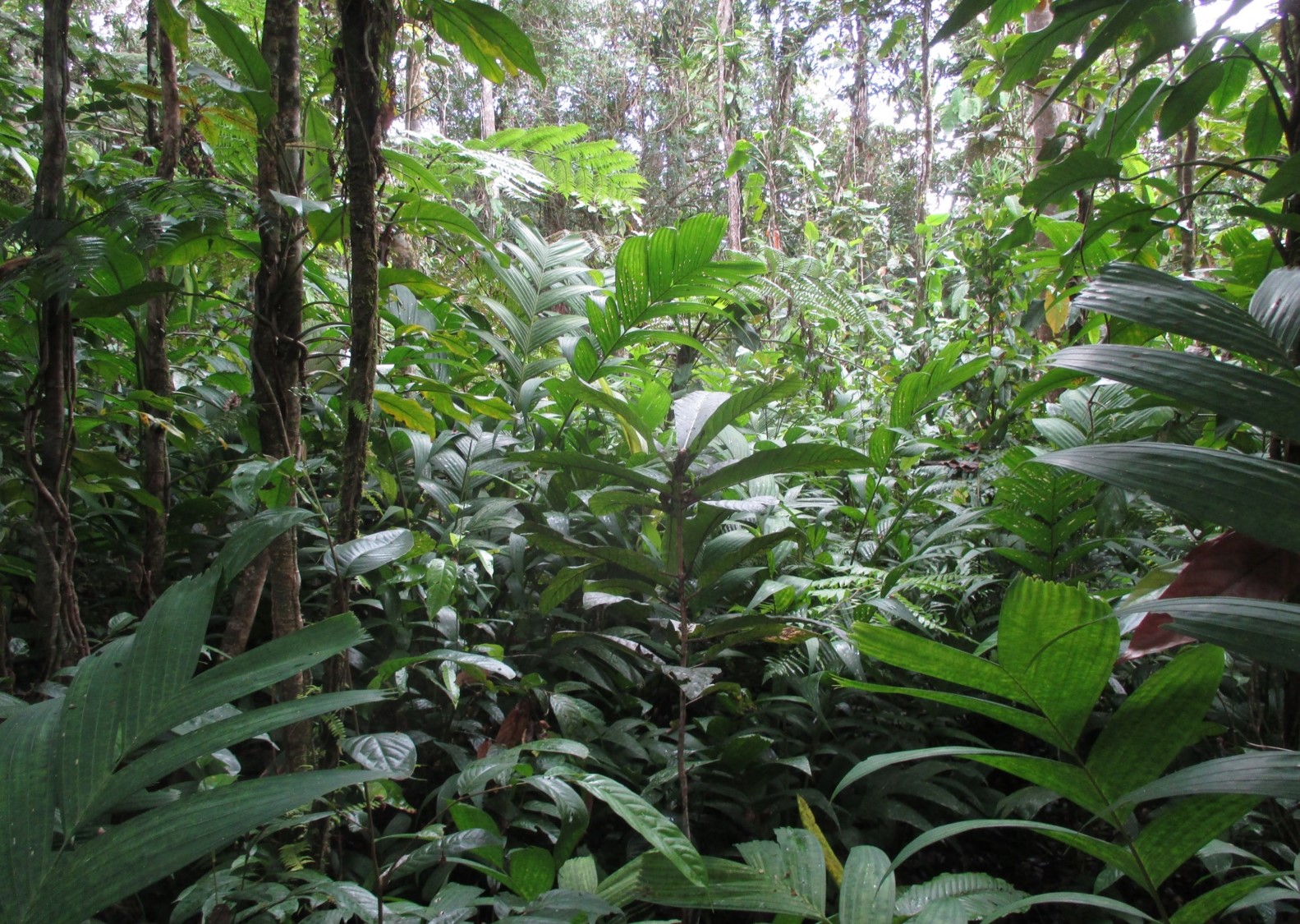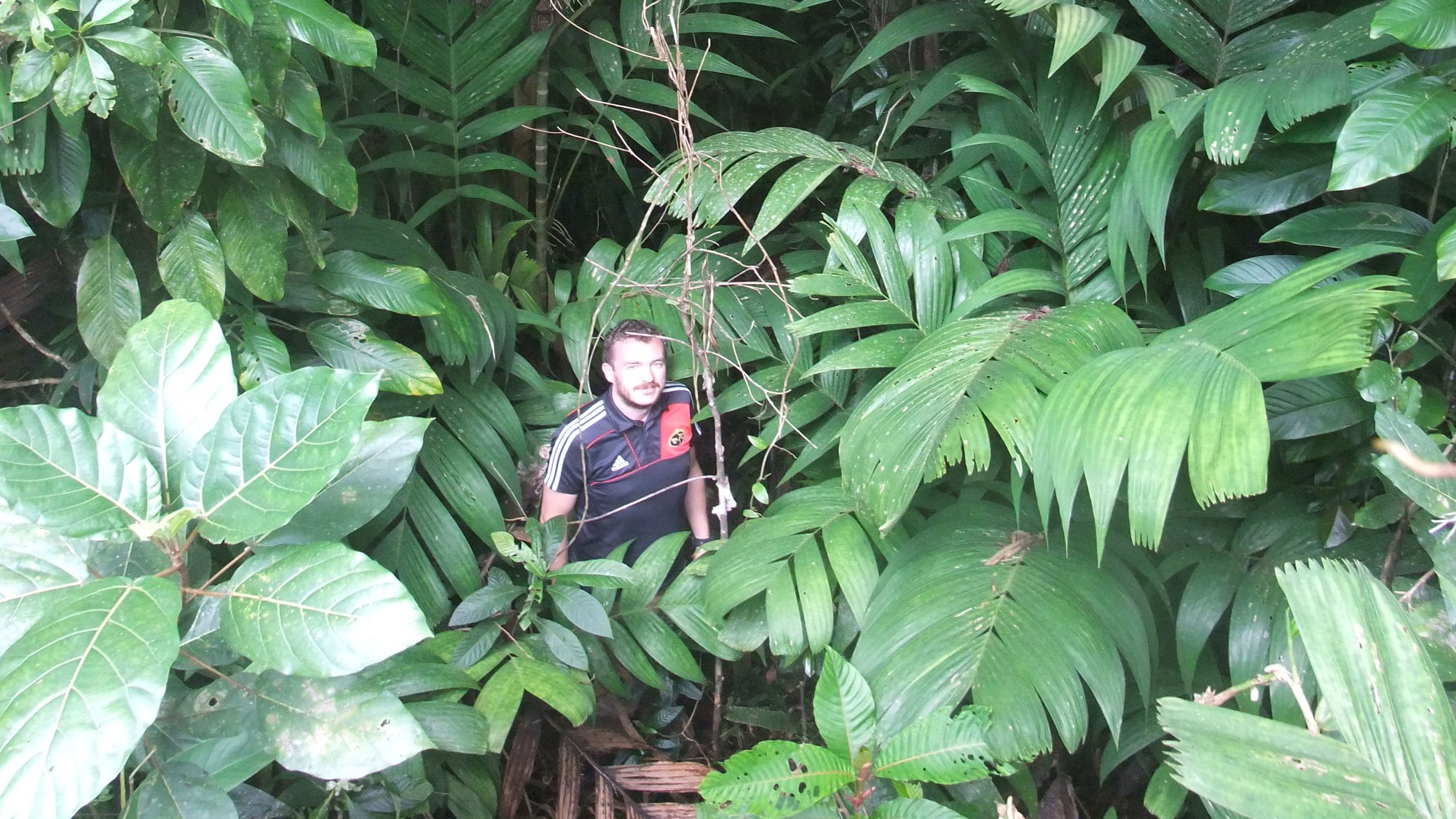Im Mittelpunkt meiner Forschung steht die Analyse der Struktur, Dynamik und Biodiversität von Wald- und Graslandökosystemen auf verschiedenen Skalenebenen unter sich ändernden Rahmenbedingungen.
Gegenstand meiner mit „summa cum laude“ bewerteten Dissertation war die Vegetationsdynamik von Schlüsselökosystemen des Alpenraumes unter dem Einfluss natürlicher Störungen (DFG-Projekt „Mosaik-Zyklus-Modelle hochdynamischer Lebensgemeinschaften des Alpenraumes“; 1994-1998). Hier stand unter anderem die störungsbedingte Dynamik alpiner Rasen und subalpiner Lärchenwälder im Fokus.
In der Folge habe ich die Langzeit-Dynamik tropischer Bergwälder (unter Einfluss von Fragmentierungsprozessen, extensiver Nutzung, biologischen Invasionen und Klimawandel) als Arbeitsschwerpunkt entwickelt (u.a. DFG-Projekt „Regeneration und Invasibilität des montanen Regenwaldes auf der Insel Hawaii“; BMBF-Projekt „CoCe: Conservation and use of wild populations of Coffea arabica in the montane rainforests of Ethiopia“).
Der Aufbau einer Forschungsgruppe mit Fokus auf Dynamik, Biodiversität und Naturschutz in Bergregenwäldern der Pazifikinseln begann 2014. Im Zentrum dieser Forschung steht ein komplexes inter- und transdisziplinäres Forschungsprojekt über die Invasion einer exotischen Palmenart in einem submontanen Waldreservat, an dem Forscher mehrerer Institute der University of the South Pacific, Regierungsinstitutionen und NGOs beteiligt sind. Dieses Projekt wird von einem internationalen Forscherteam bearbeitet, unter Beteiligung von französischen, deutschen und australischen Universitäten.
Zudem habe ich mit KollegInnen der University of Toronto und der WSL (Birmensdorf/Schweiz) eine interdisziplinäre Methodik zur Effizienzermittlung von Biotopverbundsystemen in Mitteleuropa (Langzeit-Experimente zur funktionalen Konnektivität auf Populations- und Landschaftsebene) entwickelt. Diese praxisbegleitende geobotanische Grundlagenforschung geht unmittelbar in die Naturschutzfachplanung in Bayern ein.
Aktuell: Zoonoses Emergence across Degraded and Restored Forest Ecosystems (ZOE)
Wie beinflusst die Degradierung von Wäldern das Risiko des Auftretens von vektorübertragenen Krankheiten? Das Projekt verfolgt einen ganzheitlichen, inter- und transdisziplinären One-Health-Ansatz, der die Zusammenhänge zwischen der Gesundheit von Mensch, Tier und Umwelt berücksichtigt.
Das Pinanga-Projekt
Wie verändert eine invasive Palmenart den Regenwald Fidschis?

Das Problem
Die Elfenbein-Rohrpalme (Pinanga coronata) stammt von den indonesischen Inseln Java und Sumatra und ist dort in Regenwäldern von der Küste bis auf ca. 1800 Meter Höhe über dem Meer weit verbreitet. Sie wurde in den 1970er Jahren als Zierpflanze auf die mehr als 10.000 km2 große Hauptinsel Fidschis, Viti Levu, exportiert und gelangte dort aus einem Garten in der Nähe des Waldreservates Colo-i-Suva in die Umgebung. Heute breitet sich die Art rasch aus und bildet dichte Bestände in den Mahagoni-Plantagen und umliegenden naturnahen Wäldern von Colo-i-Suva. Inzwischen dominiert sie weite Bereiche des Waldunterwuchses im Schutzgebiet.
Die Elfenbein-Rohrpalme besitzt offensichtlich beträchtliches Potential, die natürliche Biodiversität des Waldes zu reduzieren und seine Struktur, Funktion und Dynamik nachhaltig zu verändern. Sie verringert unter anderem die Licht- und Nährstoffverfügbarkeit für andere Pflanzen und verdrängt einheimische Baumfarne. Zusätzlich sind wegen der Nährstoffkonkurrenz mit Forstbäumen, insbesondere Mahagoni, negative Einflüsse auf die Erträge der Forstwirtschaft zu erwarten.
Das Projekt
Wir untersuchen die Populationsstruktur der Palme, ihren Einfluss auf abiotische Standortfaktoren und Wechselwirkungen mit dem Verhalten anderer Pflanzenarten in 35 Daueruntersuchungsflächen mit insgesamt 280 Teilflächen, die entlang eines Invasionsgradienten im Waldreservat angelegt wurden. Die Arbeiten begannen im September 2014.
Die Hauptziele des Pinanga-Projektes sind 1) zu klären, wie und in welchem Ausmaß die invasive Palmenart die Waldökosysteme in beiden Abschnitten des Waldreservats (Mahagoni-Pflanzung Colo-i-Suva und Naturwald Savura) verändert; 2) das Populationswachstum und die weitere Ausbreitung der Art vorherzusagen; 3) ausreichende Daten für eine solide und umfassende Risikobewertung zu liefern; 4) Unterstützung beim Aufbau von Kapazitäten für eine nachhaltige Bewirtschaftung der Wälder Fidschis und anderer Inselstaaten im tropischen Südpazifik zu leisten.
Förderung
- The University of the South Pacific (USP), Strategic Research Theme (SRT) Pacific Ocean & Natural Resources;
- Caribbean-Pacific Island Mobility Scheme (CARPIMS) of the European Commission (Education, Audiovisual and Culture Executive Agency, EACEA);
- New Colombo Plan (Australian Government, Department of Foreign Affairs & Trade);
- German Academic Exchange Service (DAAD); Higher Education Partnerships Project “Transnational perspectives in biodiversity education and assessment in the SW Pacific” (partner institution: University of Goettingen, Germany);
- ERASMUS, European Commission.
Partner
- Government of Fiji, Ministry of Fisheries & Forests, Suva, Republic of Fiji
- University of Goettingen, Germany
- University of South Australia (UniSA), Adelaide, Australia
- University of Rouen, France
- Massey University, Palmerston North, New Zealand
- Nature Fiji (Marqueti Fiji), Suva, Republic of Fiji
- Conservation International, Fiji Program, Suva, Republic of Fiji
- Landcare Research, Christchurch, New Zealand
Team
Senior Researchers
- Hans Juergen Boehmer, PhD (PI; Professor of Biogeography, School of Geography, Earth Science & Environment, The University of the South Pacific and Institute for Applied Ecological Studies, Nuremberg)
- Nicholas Rollings, PhD (Associate Professor of Geospatioal Science, School of Geography, Earth Science & Environment, The University of the South Pacific)
- Gunnar Keppel, PhD (Associate Professor in Environmental Biology, School of Natural and Built Environments, The University of South Australia)
- John H. Lowry, PhD (Senior Lecturer in Geospatial Science, School of People, Environment and Planning, Massey University, New Zealand)
- Stephen Galvin, PhD (Lecturer in Physical Geography, School of Geography, Earth Science & Environment, The University of the South Pacific)
- Estelle Forey, PhD (Maître de conférences, HDR; Groupe de Recherche ECODIV, Faculté des Sciences & des Techniques, Université de Rouen)
- Matthieu Chauvat, PhD (Professeur d’Université, ECODIV IRSTEA URA/EA 1293, Faculté des Sciences & des Techniques, Université de Rouen)
- Esther Fichtler, PhD (TROPAGS – Tropical Plant Production and Agricultural Systems Modelling, University of Goettingen, Germany)
- Michelle McKeown, PhD (Ecosystems & Global Change Group, Landcare Research, New Zealand)
- Stefan Erasmi, PhD (Cartography, GIS & Remote Sensing Group, Department of Geography, University of Goettingen, Germany)
- Dominik Seidel, PhD (Faculty of Forest Sciences and Forest Ecology, University of Goettingen, Germany)
- Peter Annighoefer, PhD (Faculty of Forest Sciences and Forest Ecology, University of Goettingen, Germany)
Junior Researchers
- Sherri Lodhar (School of Geography, Earth Science & Environment, The University of the South Pacific)
- Geon C. Hanson (School of Geography, Earth Science & Environment, The University of the South Pacific)
- Sunil Gopaul (School of Geography, Earth Science & Environment, The University of the South Pacific)
- Michael J. Dyer (School of Geography, Earth Science & Environment, The University of the South Pacific & School of Natural and Built Environments, The University of South Australia)
- Marie-Isabell Lenz (School of Geography, Earth Science & Environment, The University of the South Pacific & Department of Geography, University of Goettingen, Germany)
- Jean-Benoit Mathieu (School of Geography, Earth Science & Environment, The University of the South Pacific & Faculty of Forestry, Geography and Geomatics, Université Laval, Quebec, Canada)
- Julia Morley (Faculty of Forest Sciences and Forest Ecology, University of Goettingen, Germany)

Dr. Stephen Galvin zwischen Wedeln der Elfenbein-Rohrpalme im Waldreservat Savura, Viti Levu, Fidschi
Teilprojekte
Galvin, Stephen (Postdoc research, ongoing): A dendroecological assessment of the impact of invasive alien Ivory cane palm (Pinanga coronata) on Mahogany (Swietenia macrophylla) in the Colo-i-Suva forest reserve, Viti Levu, Fiji Islands. The University of the South Pacific, Faculty of Science, Technology & Environment (FSTE). (joint project with Dr Esther Fichtler, Department of Crop Sciences, University of Goettingen, Germany).
Lodhar, Sherri (PhD, ongoing): Structure and dynamics of a Pacific submontane rainforest under impact of an alien understory tree invasion. The University of the South Pacific, Faculty of Science, Technology & Environment (FSTE). (joint supervision with Professor Estelle Forey-Leyssenne, Groupe de Recherche ECODIV, University of Rouen, France).
Julia Morley (BA in Forest Ecology, completed 2019): Using terrestrial laser scanning to quantify the effects of the invasive alien ivory cane palm (Pinanga coronata) on forest structure in a tropical Pacific island forest reserve. Faculty of Forest Science and Forest Ecology, Georg-August University of Goettingen, Germany.
Gopaul, Sunil (Master in Environmental Science, completed in 2018): Abiotic effects of the invasive alien palm Pinanga coronata in the Colo-i-Suva Forest Reserve, Fiji. The University of the South Pacific, Faculty of Science, Technology & Environment (FSTE). (joint supervision with Dr Michelle McKeown, Landcare Research, NZ).
Hanson, Geon C. (Master in Environmental Science, completed in 2017): Population structure, allometry, and spread of alien ivory cane palm, Pinanga coronata, in a protected forest landscape on Viti Levu, Fiji. The University of the South Pacific, Faculty of Science, Technology & Environment (FSTE).
Dyer, Michael J. (Honours, completed in 2016): The distribution of the invasive palm Pinanga coronata and its effects on native tree ferns in the Colo-i-Suva area, Viti Levu, Fiji. The University of the South Pacific, Faculty of Science, Technology & Environment (FSTE) & The University of South Australia (UniSA). (joint supervision with Dr Gunnar Keppel, University of South Australia; this research was awarded the UniSA Honours Medal 2017; see http://w3.unisa.edu.au/unisanews/2017/September/story13.asp).
Marie-Isabell Lenz (BA in Geography, completed in 2016): Risk assessment of the invasive alien ivory-cane Palm (Pinanga coronata) in the islands of the tropical South Pacific. The University of the South Pacific, Faculty of Science, Technology & Environment (FSTE) & Georg-August University of Goettingen, Germany. (joint supervision with Dr Stefan Erasmi, Department of Geography, University of Goettingen, Germany).
Jean-Benoit Mathieu (BA in Geography, completed in 2015): Diversity of understory vegetation in a submontane tropical rainforest under impact of an invasive alien palm species. The University of the South Pacific, Faculty of Science, Technology & Environment (FSTE) & University of Laval, Quebec, Canada.
Publikationen
Morley, J., Annighöfer, P., Seidel, D., Lodhar, S.Y.F., Gopaul, S., Galvin, S., Lowry, J.H., Boehmer, H.J. (in prep.): Effects of an invasive alien palm on forest structure in a tropical island forest reserve.
Lodhar S.Y.F., Forey E., Galvin S. D., Lowry, J. H., Gopaul, S., Hanson, G. C., Chauvat, M., Boehmer H. J. (in prep.): Invasion by an alien palm in Fiji’s tropical rainforest lead to selective biotic filtering of resident plant communities towards more competitive functional traits.
Lenz M.-I., Galvin S., Keppel G., Gopaul S., Kowasch M., Watling D., Dyer M.J., Lodhar S., Hanson G.C., Erasmi S. & H.J. Boehmer (2022): Where to Invade Next: Inaction on Biological Invasions Threatens Sustainability in a Small Island Developing State of the Tropical South Pacific. – In: Low, P.S. (ed.) Sustainable Development – Asia-Pacific Perspectives, Chapter 30. Cambridge University Press.
Forey E., Lodhar S. Y. F., Gopaul S., Boehmer H. J., Chauvat M. (2021): A functional trait-based approach to assess the impact of an alien palm invasion on plant and soil communities on a South Pacific island. – Austral Ecology 46 (3), 398-410.
Boehmer, H.J., Pscherer, J., van Eyk, J. & Lenz, M.-I. (2020): Insulare Biodiversität und ihre Gefährdung im Südpazifik. – In: Dickel, M., Kowasch, M. (ed.) Geographien Ozeaniens – Fachliche Annäherungen und Didaktisierungsvorschläge, 165-185. Lit-Verlag (= Reihe Praxis Neue Kulturgeographie).
Dyer M.J., Keppel G., Watling D., Tuivava M., Vido S. & H.J. Boehmer (2019): Using expert knowledge and field surveys to guide management of an invasive alien palm in a Pacific Island lowland rainforest. In: C.R. Veitch, M.N. Clout, A.R. Martin, J.C. Russell and C.J. West (eds.), Island invasives: scaling up to meet the challenge, pp. 417–423. Occasional Paper SSC no. 62. Gland, Switzerland: IUCN.
Dyer M.J., Keppel G., Tuiwawa M., Vido S. & H.J. Boehmer (2018): Invasive alien palm Pinanga coronata threatens native tree ferns in an oceanic island rainforest. – Australian Journal of Botany. (https://www.publish.csiro.au/BT/BT18088)
Boehmer, H. J., Hanson, G. C., Lodhar, S. Y. F., Mathieu, J.-B., Lenz, M.-I., Galvin, S. and Lowry, J. H. (2016) Rapid emergence of a novel ecosystem in a Pacific island forest reserve. Proceedings of the 49th Annual Meeting of the Ecological Society of Germany, Austria and Switzerland, pp. 276–277.
Präsentationen
Boehmer H.J.: Where to invade next – Biological Invasions and Sustainability in the South Pacific. University of Passau, Germany, Department of Geography, May 2020.
Boehmer H.J.: Risk, Vulnerability and Resilience – The Recent Dynamics of Mountain Regions as an Interdisciplinary Challenge. University of Innsbruck, Department of Geography, January 2020.
Lodhar S.Y.F., Forey E., Galvin S., Boehmer H.J.: A tropical oceanic island rainforest under impact of invasive Ivory cane palm (Pinanga coronata). R&D Conference on Invasive Alien Species Management and Biosecurity Measuresin the Asia Pacic 2019. Manila, Philippines, July 2019.
Forey E., Boehmer H.J., Lodhar S. and M. Chauvat : An invasive palm tree modifies the functional structure and linkages of above and belowground communities in South Pacific Fiji Islands. GDR CNRS 3647 Biological Invasion, Rennes, France, Oct 2018.
Boehmer H.J.: Forschen in einer anderen Welt – Zur neuen Walddynamik auf pazifischen Inseln. University of Jena, Germany, Department of Geography, June 2018.
Boehmer H.J.: Invasive alien ivory cane palm (Pinanga coronata) affects Fiji’s native plant biodiversity. Pacific Invasives Partnership (PIP), Suva, Fiji, Oct 2017.
Gopaul S.: Breaking the Wall of Invasion Biology: on how to minimise the spread of an invasive pest and restore native flora in Fiji. Australian Falling Walls Lab, Canberra, Sep 2017. (http://www.scoop.co.nz/stories/SC1709/S00013/five-emerging-bright-minds-off-to-australia.htm) and (https://www.royalsociety.org.nz/news/five-emerging-bright-minds-off-to-australia-to-pitch-their-innovative-ideas/) and (https://www.royalsociety.org.nz/what-we-do/funds-and-opportunities/falling-walls-lab/alumni-falling-walls-lab-new-zealand/2017-falling-walls-lab-new-zealand-alumni/recipients/)
Dyer, M.J.B. and G. Keppel: Using expert knowledge and field surveys to manage an invasive alien palm in a Pacific Island Rainforest: Scaling up to the challenge. University of Goettingen, Germany, Biogeography Lab, Aug 2017.
Dyer, M.J.B., Keppel, G. and H.J. Boehmer: Using expert knowledge and field surveys to manage an invasive alien palm in a Pacific Island lowland rainforest. IUCN Island Invasives Conference, Dundee, Scotland, Jul 2017.
Dyer, M.J.B., Keppel, G. and H.J. Boehmer: Using expert knowledge and field surveys to manage invasive plants in Pacific Island lowland rainforest. SPREP Staff Seminar Series to the Deputy High Commission to Samoa from Australia, Apia, Samoa, Jun 2017.
Dyer, M.J.B., Keppel, G. and H.J. Boehmer: The invasion history of Pinanga coronata on Viti Levu, Fiji and its competition with native tree ferns in the understory of lowland rainforests. The University of South Australia, Pacific Biogeography Collaboration, Jan 2017.
Dyer, M.J.B.: The distribution and effect of the invasive palm Pinanga coronata on native tree ferns in mahogany plantations and lowland rainforests. IUCN Oceania (Suva), Nov 2016.
Dyer, M.J.B.: The distribution and impacts of the invasive palm tree Pinanga coronata on native vegetation in Colo-i-Suva Forest Park and Savura Forest Reserve. The University of the South Pacific, Suva, Nov 2016.
Dyer, M.J.B.: From a voyage on the STS Young Endeavour to studying biological invasions in the South Pacific. The Australian Plant Society, Adelaide Chapter, Nov 2016.
Boehmer H.J.: Structure and dynamics of Viti Levu´s rainforests under impact of invasive alien Pinanga coronata. Poster presentation, The University of the South Pacific, Suva, Nov 2016.
Boehmer H.J., Hanson G.C., Lodhar S., Matthieu J.-B., Lenz M.-I., Galvin S. and J.H. Lowry: Rapid emergence of a novel ecosystem in a Pacific island forest reserve. Annual meeting of the Ecological Society of Germany, Austria and Switzerland, Marburg, Germany, Sep 2016.
Lowry J.H., Hanson G., Lodhar S., and H.J. Boehmer: Structure and dynamics of Fiji’s montane forests under impact of invasive alien Pinanga coronata. Pacific Science Inter-Congress, PABITRA session, Taipeh, June 2016.
Boehmer H.J.: Recently spreading ivory cane palm (Pinanga coronata) – an upcoming threat to Fiji’s native biodiversity? IUCN, Protected Areas Committee, Fiji: Suva, Oct 2015.
Boehmer H.J.: Long-term dynamics of Pacific montane forests. Centre of Biodiversity and Sustainable Land Use (CBL), Section for Tropical and Subtropical Agriculture and Forestry (SETSAF). University of Goettingen, Germany, June 2015.
